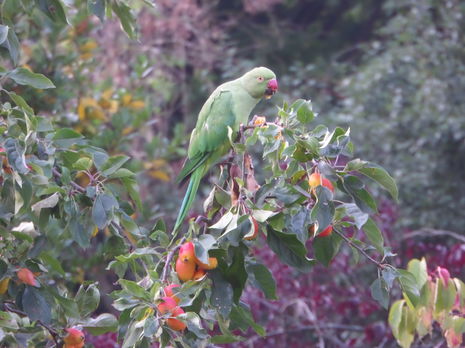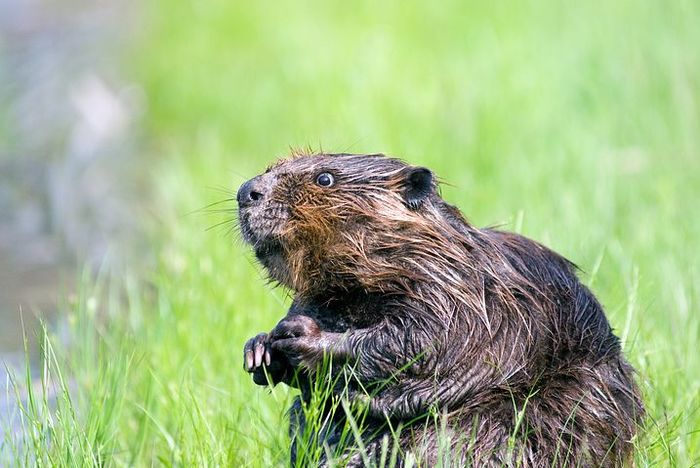It’s not easy being green: the curious case of London’s parakeets
Ben Hollingdale explores the mysterious appearance of these exotic birds in Great Britain, and their effect on our native wildlife.

A sultry Saturday afternoon in mid-August brings me, like many others, to London’s Hyde Park – one of the largest green spaces in the city centre. Venturing further into the park, the tips of the tallest buildings begin to disappear beyond the treeline; it would almost be possible to forget that this was London were it not for the ensemble of engine noises coming from double-decker buses and taxicabs currently at a standstill on Bayswater Road. Planes pass overhead and tube-trains rattle beneath the ground, but by far the most disquieting sound – and perhaps the most unexpected – is the shrill squawking of a gang of Indian ring-necked parakeets (Psittacula krameria) fighting over a disused box of monkey nuts from the Whole Foods Market on Kensington High Street.
For the last 50 years, these lurid green birds have found a home in the leafier suburbs of London and the South East, but in the summertime have been spotted as far north as Glasgow’s Victoria Park. A 2001 study pinpoints the species origin of the UK population as a hybrid of two Asian subspecies, P.k. borealis and P.k. manillensis, which populate the foothills of the Himalayas and some of the more temperate regions of North Africa. Exactly how they came to the UK in the first place, however, is as much the stuff of dinner party conversation as it is of hard science. At one function, a family friend tells me that she heard they escaped from Kew Gardens during the Great Storm of 1987. My Dad instead postures an escape from the set of The African Queen starring Humphrey Bogart, which was filmed at Ealing Studios in southwest London in 1951. Perhaps my favourite of these oral histories suggests Britain’s parakeets can be traced back to a single breeding pair, Adam and Eve, released as a gesture of free love by the guitarist Jimi Hendrix from his then girlfriend’s flat near Carnaby Street in the 1960s.
"Exactly how they came to the UK in the first place, however, is as much the stuff of dinner party conversation as it is of hard science."
Hendrix historians have denied this last story and academic ornithologists dispute the others – instead hypothesising multiple outbreaks on multiple occasions from pet shops, private gardens and aviaries before 1971. It’s likely that rising concerns surrounding Parrot flu (Psittacosis), which made rounds in the booming exotic pet trade of the 1960s and 70s, led some owners to intentionally release the birds for fear of putting other animals at risk. Others may have simply left cage doors open by mistake, only to come home and find them empty. Inherently social birds, the fugitives would flock together upon escape before making roost in the many green spaces around the city.
Whatever their origin, the parakeets thrived here in the UK. Partial to the temperate climates and rich pickings of the many gardens – which now represent more of the UK’s biodiversity than rural areas – they have been steadily growing in number in the UK since 1983. The current population size is estimated to be around 50,000, and, against a backdrop of avifauna in decline, they are projected to become one of Britain’s most common birds over the next few years. While increases in global average temperature have made British summers more hospitable to the colourful visitors, there is evidence of prior adaptation to colder climates, corroborating the theory that they escaped from the exotic bird trade. The adaptation of farming practices to increases in global average temperatures has also facilitated the growth of non-native parrot populations in Europe and the Middle East. The largest UK roosts could once be found at Esher Rugby Club, which saw up to 7000 birds until they were destroyed due to unrelated tree surgery. Their ubiquity in certain parts of London has led some locals to start calling them “posh pigeons”.
Not everyone is pleased to see them, however. Voracious and opportunistic feeders, some birdwatchers (and scientists) fear their noisy and aggressive behaviour is driving the decline of native birds. The European research collaboration group ParrotNet presented the results of a four-year research programme into the impacts of invasive parakeets on native biodiversity at the Department for Environment, Food and Rural Affairs (DEFRA) in 2014. Speaking to The Guardian, the organisation’s co-founder, Hazel Jackson, described the parakeets not as posh pigeons but an “urgent economic, societal and environmental problem.” Parakeets breed earlier in the season than many endemic cavity nesters like woodpeckers, tits and bats. With limited availability of nesting sites, native nesters could potentially be driven out as the parakeet population continues to rise. For rare species, this could drive population decline even further – much like the introduction of the grey squirrel for the red squirrel. Elsewhere in the world, parakeets are considered serious agricultural pests; in Israel, monk parakeets (Myiopsitta monachus), also known as Quaker parrots, have been devastating soft fruit and nut harvests for several decades, and ParrotNet warns similar damage is possible here in the UK.
Since 2009, DEFRA has listed ring-necked parakeets among pest species that may be lawfully killed without a license – provided they present a serious threat to livestock, public safety or the conservation of wild birds – although there has yet to be a general cull. Their popularity among birdwatchers and the general public could account for the reluctance to introduce more hostile legislation.
A cull, however, might be surplus to requirements. The booming parakeet population is thought to be linked to increases in the numbers of birds of prey in the London area. Observations by ornithologists Ralph Hancock and Jeff Martin reveal ring-necked parakeets are regularly snatched by sparrowhawks, tawny owls and peregrine falcons just a stone’s throw from where this article was conceived in Hyde Park. How this might shape population sizes in the future is yet to be fully comprehended.
The curious case of London’s parakeets is but an isolated example of how humans impact ecosystems through the introduction of invasive species. Some view the exotic aliens as a welcome break from the monotony of urban living, while others fear for endemic species that could be threatened by their competitive exclusion. Like them or not, the parakeets appear to be here to stay, carrying a colourful tale of invasion, adaptation and conservation under their wings.
 Comment / Plastic pubs: the problem with Cambridge alehouses 5 January 2026
Comment / Plastic pubs: the problem with Cambridge alehouses 5 January 2026 News / New movement ‘Cambridge is Chopped’ launched to fight against hate crime7 January 2026
News / New movement ‘Cambridge is Chopped’ launched to fight against hate crime7 January 2026 News / Uni-linked firms rank among Cambridgeshire’s largest7 January 2026
News / Uni-linked firms rank among Cambridgeshire’s largest7 January 2026 News / SU stops offering student discounts8 January 2026
News / SU stops offering student discounts8 January 2026 News / Cambridge businesses concerned infrastructure delays will hurt growth5 January 2026
News / Cambridge businesses concerned infrastructure delays will hurt growth5 January 2026









